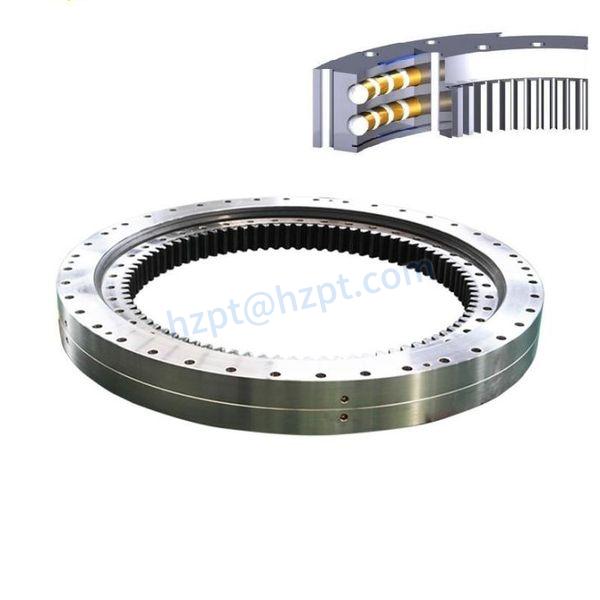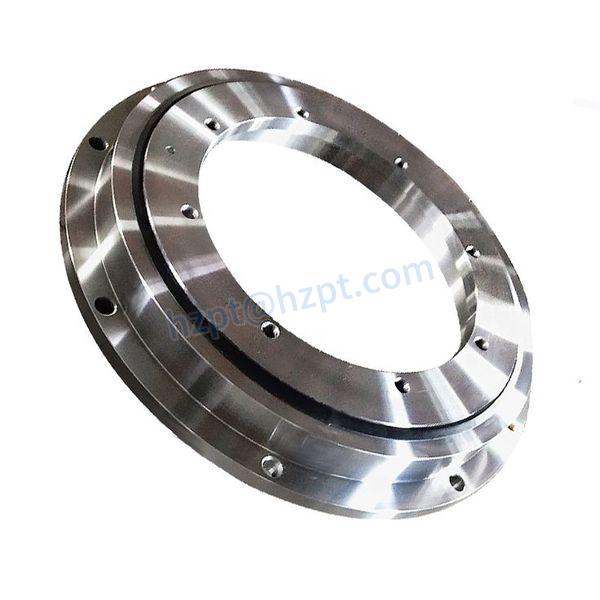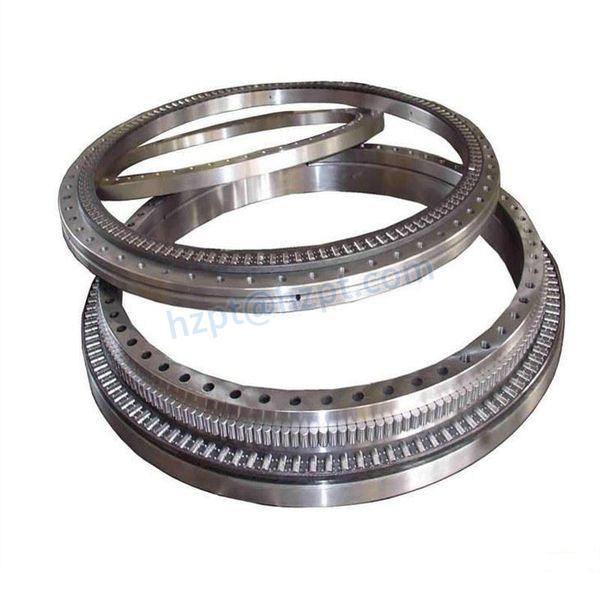Product Description
Precision Cross Roller Bearing, the inner structure of which adopts the vertical and cross arrangement of cylindrical rollers with 90°, can bear radial load, double-direction thrust loads and overturning moment at the same time. Combined with its high rigidity, it can be applied to the joints and rotating parts of industrial robots, rotary tables of machining centers, rotating parts of manipulators, precision rotary tables, medical equipments, measuring instruments, IC manufacturing machines, etc.
Precision Cross Roller Bearing has 3 structure types, including bearing with cage, with separator, and with full complement. Cage and separator types are suitable to low friction moment and high-speed rotation, while full complement is suitable to low-speed rotation and heavy load.
Precision Cross Roller Bearing has the following 7 structure series:
Precision Cross Roller Bearing has the following 7 structure series:
| RB Series |
| RE Series |
| RU Series |
| RA Series |
| RA-C Series |
| CRB Series |
| CRBH Series |
Technological Process
All the forging will be inspected to ensure there is no defect in the material.
Rough Turning with 2-3mm allowance according to the drawing, at the same time every parts will be inspected to ensure the dimension is satisfy with the drawing requirements.
Finish lathing with 2-5mm allowance according to the drawing, all the parts will be inspected to ensure the dimension is satisfy with the drawing requirements
The tolerance of center diameter shall be 0.05mm, and the holes shall meet the drawing requirements . The holes of each part shall be tested to ensure that they meet the requirements of the drawing.
Quenching will be done on the raceway of the bearing to improve the hardness, CZPT resistance and fatigue strength of the bearing. The hardness will be satisfy with customer’s requirements after quenching. after quenching,the outer diameter,ovality will be inspected.
Grinding include rough grinding,regrinding and finished grinding. After each grinding processing, the bearing will be tempered to prevent the deformation and cracking, and release the internal stress to make the material stable,and ensure the processing accuracy, then the next grinding will be done, Top and bottom surface,inner and outer diameter, raceway will be grinded to make the dimension and the precision meet the drawing requirements, every parts will be inspected to ensure all the bearing meet the drawing requirements
100% inspection shall be carried out on each part to ensure the inner diameter, outer diameter, surface and raceway of the bearing ring can satisfy the drawing requirements, and ready for assembly.
Final inspection will be done after assembly to ensure all the bearing are 100% qualified.
Typing according to the customer’s requirements, or typing our company’s brand, and the bearing will be packaged by Plastic film+plywood case, or according to the customer’s requirements.
/* January 22, 2571 19:08:37 */!function(){function s(e,r){var a,o={};try{e&&e.split(“,”).forEach(function(e,t){e&&(a=e.match(/(.*?):(.*)$/))&&1
| Standard or Nonstandard: | Standard |
|---|---|
| Feature: | High Speed, Vacuum, Antimagnetic, Cold-Resistant, Corrosion-Resistant, Heat-Resistant |
| Sealing Gland: | Sealed On One Side |
| Rolling-Element Number: | Single-Row |
| Material: | Bearing Steel |
| Type: | No Gear |
| Samples: |
US$ 10/Piece
1 Piece(Min.Order) | |
|---|
| Customization: |
Available
| Customized Request |
|---|

How do Environmental Factors such as Temperature and Exposure to Corrosive Substances Impact Slewing Bearings?
Environmental factors, including temperature variations and exposure to corrosive substances, have a significant impact on the performance and longevity of slewing bearings. Here’s how these factors affect slewing bearings:
- Temperature Extremes:
High Temperatures: Excessive heat can lead to premature bearing failure by affecting the lubrication properties, causing thermal expansion, and accelerating wear. Bearings operating at high temperatures require special lubricants and materials that can withstand thermal stresses.
Low Temperatures: Extremely low temperatures can lead to reduced lubricant viscosity, increasing friction and wear. Bearings operating in cold environments might require low-temperature lubricants and materials that maintain their properties in freezing conditions.
- Corrosive Substances:
Moisture and Water: Exposure to moisture and water can lead to rust, corrosion, and erosion of bearing components. This is particularly relevant in marine environments or applications exposed to frequent wet conditions.
Chemical Exposure: Corrosive chemicals and aggressive substances can deteriorate bearing materials and lubricants, leading to accelerated wear and potential structural damage.
Dust and Particles: Dust, dirt, and particles can infiltrate the bearing, causing abrasive wear and increasing the risk of damage to the rolling elements and raceways.
- Effects on Lubrication:
Temperature extremes and exposure to corrosive substances can compromise the effectiveness of lubrication. High temperatures can degrade lubricants, while corrosive environments can contaminate or dilute lubricants, reducing their protective qualities.
- Material Selection:
When designing slewing bearings for specific environments, choosing appropriate materials is crucial. Stainless steels, specialized coatings, and corrosion-resistant materials are often preferred for applications where corrosion is a concern.
- Sealing Solutions:
Effective sealing solutions are essential to protect slewing bearings from moisture, chemicals, and contaminants. Proper sealing helps maintain lubrication integrity and prevents external substances from entering the bearing.
- Maintenance and Inspection:
Regular maintenance and inspections are critical in environments with temperature fluctuations and corrosive exposure. Prompt removal of contaminants, re-lubrication, and replacement of damaged parts can mitigate the effects of these factors.
- Application-Specific Considerations:
Understanding the environmental conditions of the application is essential for selecting the appropriate slewing bearing type, materials, and maintenance practices. Customized solutions might be necessary for extreme environments.
In summary, temperature variations and exposure to corrosive substances can degrade the performance and durability of slewing bearings. Proper material selection, sealing, lubrication, and maintenance practices are vital for ensuring the bearings’ reliability in challenging environmental conditions.

How does Proper Lubrication Impact the Performance and Longevity of Slewing Bearings?
Proper lubrication plays a crucial role in enhancing the performance and extending the longevity of slewing bearings. Here’s how it impacts these aspects:
- Reduced Friction and Wear:
Lubrication forms a protective layer between the rolling elements and raceways, reducing friction and wear. This minimizes surface contact and prevents metal-to-metal contact, leading to less wear and extended bearing life.
- Heat Dissipation:
Lubrication helps dissipate heat generated during operation. Adequate heat management prevents overheating, which can otherwise lead to premature bearing failure and reduced efficiency.
- Corrosion Protection:
Lubricants with anti-corrosion properties form a barrier that protects bearing surfaces from moisture and environmental contaminants. This is crucial in preventing rust and corrosion, especially in challenging operating environments.
- Sealing Effect:
Lubrication can enhance the sealing effect of bearing seals, preventing the ingress of dust, dirt, and other particles. This maintains the integrity of the bearing’s internal components and reduces the risk of contamination-related failures.
- Noise and Vibration Reduction:
Properly lubricated bearings generate less friction and operate more smoothly, resulting in reduced noise and vibration levels. This is particularly important in applications where noise reduction is essential.
- Improved Efficiency:
Effective lubrication minimizes energy losses due to friction, leading to improved overall efficiency of machinery. This is significant in applications that require high performance and energy savings.
- Prevention of Micro-Movements:
Lubrication helps prevent micro-movements between the rolling elements and raceways, reducing wear caused by repeated impacts and vibrations during operation.
- Maintenance Reduction:
Proper lubrication reduces the need for frequent maintenance and replacement of bearings. This not only saves time and resources but also contributes to increased uptime and reduced operational disruptions.
- Longevity:
By reducing wear, preventing corrosion, and managing heat, proper lubrication significantly extends the lifespan of slewing bearings. This, in turn, contributes to improved equipment reliability and reduced lifecycle costs.
In conclusion, proper lubrication is essential for optimizing the performance, efficiency, and durability of slewing bearings. Regular maintenance and adherence to manufacturer-recommended lubrication intervals ensure that the bearings operate smoothly and consistently over their operational life.

What Factors Should Be Considered When Selecting a Slewing Bearing for a Specific Application?
Selecting the right slewing bearing for a specific application requires careful consideration of various factors to ensure optimal performance and longevity. Some crucial factors to take into account include:
- Load Requirements: Determine the axial, radial, and moment loads that the slewing bearing will need to support. Choose a bearing with an appropriate load-carrying capacity for the application.
- Space Limitations: Consider the available installation space, both in terms of diameter and height. Choose a slewing bearing that fits within the allocated space without compromising functionality.
- Rotational Speed: Determine the required rotational speed of the bearing. Higher rotational speeds may require bearings with advanced designs and materials to manage heat and wear.
- Environmental Conditions: Assess the operating environment for factors like temperature, humidity, dust, and corrosive substances. Select a bearing with suitable seals and coatings to withstand these conditions.
- Accuracy and Precision: For applications requiring precise positioning, such as robotics or industrial machinery, choose a bearing that offers the necessary level of accuracy in rotation.
- Mounting and Assembly: Consider the ease of installation and any special mounting requirements. Some bearings come with integrated mounting features, simplifying the assembly process.
- Lubrication and Maintenance: Evaluate the lubrication needs of the bearing. Some bearings require periodic maintenance, while others are designed for long-term lubrication.
- Expected Lifespan: Determine the desired lifespan of the bearing in relation to the application’s operational requirements. High-quality bearings with robust construction may offer longer service life.
- Cost-Benefit Analysis: Balance the initial investment with long-term benefits. Consider factors like maintenance costs, downtime, and overall equipment performance.
- Industry Standards: Ensure that the selected slewing bearing complies with relevant industry standards and regulations for safety and quality.
Ultimately, the selection process involves matching the unique requirements of the application with the capabilities of the slewing bearing. Consulting with bearing manufacturers and experts can provide valuable insights to make an informed decision.


editor by CX 2024-03-27
Leave a Reply